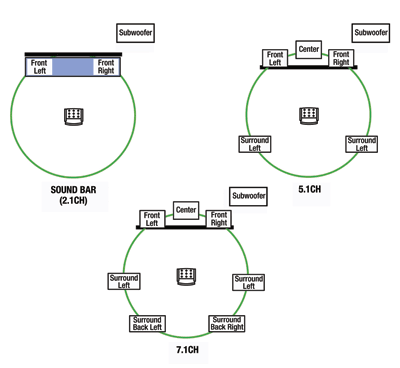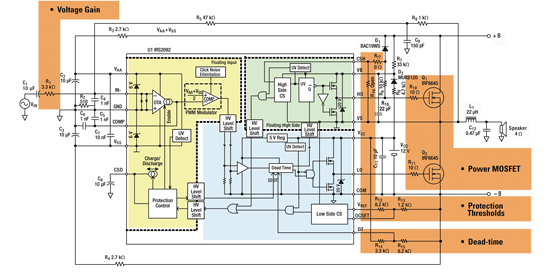A flexible solution for Class D audio amplifiers
How to efficiently design different number of channels in multiple products with same design
BY JUN HONDA
International Rectifier, El Segundo, CA
www.irf.com
Audio systems used in home entertainment are becoming more feature rich as new media and formats demand extended audio features. One example is the AV receiver and home theater system. From a DVD that contains 5.1-channel audio tracks to a Blu-ray Disc that carries 7.1-channel surround sound, newer formats are increasing the number of audio channels.
The Sound Bar system, with two to four channels to assist weak audio performance of thinner flat TVs is another good example. To address the variations in the different number of channel configurations, IR has developed a three-channel Class D amplifier driver, the IRS2053M, and the four-channel IRS2093M to accompany the IRS2092(S) single-channel driver. The 7.1-channel Blu-ray Disc system can be build with two four-channel drivers, while the three-channel Sound Bar system can be built with a three-channel IC. At the same time, consumers are demanding sophisticated and aesthetically pleasing appearance of the equipment.
This article demonstrates how to efficiently design different number of channels in multiple products with same design.
New media; more channels
Before the advent of DVD, users listened to music with a two-channel stereo. The DVD introduced up to six channels with the Dolby Digital audio format for movie playback. The Blu-ray Disc supports up to eight channels. At the same time, more consumers began using computer-based entertainment systems in their living room with its convenient on-demand content streaming services and internet browsing. Preparing for this trend, Intel updated its AC’97 audio codec standard to High Definition (HD) Audio capable of up to eight channels of audio tracks.
New media; higher-definition format
To enhance the user experience, codec formats have been upgraded. The Compact Disc, which came out in 1982, replaced other forms of analog audio media with its two-channel 16-bit resolution at a 44.1-kHz sampling rate. The DVD offered configuration options at various sampling rates up to 192 kHz with 24-bit resolution. Now the Blu-ray Disc offers up to eight channels and higher bit rates. For this reason, audio amplifiers require compact yet higher audio performance.
Energy savings in home entertainment
The issue of energy savings is becoming increasingly important to consumers. For example, the latest Energy Star Standard Version 2.0 Audio/Video Specification sets energy-efficiency goals in audio amplifiers during normal operating conditions in addition to standby power consumption in home entertainment systems.
The requirements accelerate conversion from linear mode amplification classes such as commonly used Class AB to Class D. To meet today’s stringent Energy Star efficiency criteria, the Class D amplifier is the solution of choice.
Typical home entertainment system configurations
The home entertainment system encircles the audience with speakers as shown in Fig. 1 . For a simpler setup, the virtual surround technique is a convenient way to simulate the surround-sound experience with fewer speaker systems. This results in various system configurations.
One example of a virtual surround application is an entry-level home theater system called the Sound Bar. This system uses 2.1 channels that use two full-range speakers and a subwoofer to create a perception that there are more speakers outside the equipment.

Fig. 1. Home entertainment audio system configurations.
Class D amps save space, energy
While newer media formats demand more audio playback channels from a box, consumers demand that the equipment have a sophisticated and aesthetically pleasing appearance. Taking advantages of high-efficiency Class D topology simplifies thermal management to cut bulky mechanical components.
The Class D audio amplifier, whose operational concept was invented decades ago, is now an attractive viable solution enabled by the advancement of switching device technologies in addition to small size and comparable audio performance to today’s silicon figure of merit. The highly efficient topology allows designers to integrate multiple channels in a small space as a result of its significantly lower heat dissipation compared to a traditional Class AB amplifier.
Scalable design unifies platform
To accommodate a variation of audio configurations from two to eight channels with 50 to 250 W per channel to address different media or different grades of products, designers benefit from scalable design features. By using such a chipset approach, one unified system design can address many product lines with same technical competence.
For example, International Rectifier offers single-, triple-, and quadruple-channel Class D audio amplifier driver ICs IRS2092(S), IRS2053M, and IRS2093M along with a range of MOSFETs to design different numbers of channels with output power on the same base design.
By unifying three important common features (PWM modulator design, gate drive design, and protections design), these ICs offer a convenient scalability feature. The one-, two-, and three-channel Class D amplifier driver ICs use the same design core so designers stay in the same overall design and hence save design time to market.
To design various products on the scalable design platform, designers change only a small segment of the design (see Fig. 2 ). First, choose a MOSFET to the target output power by determining the amp’s operating voltage. This sets the MOSFET voltage rating. Because power dissipation in MOSFET has a minimum value at a certain balance between on-resistance (RDS(on) ) and gate charge (Qg ). The largest die size is not the answer for all power levels.

Fig. 2. Tailoring design to a given spec in a scalable design platform.
Once the MOSFET is selected, choose a most convenient and cost effective driver IC(s) according to the required number of channels. Select the appropriate dead-time amount according to the gate charge of the MOSFET. Larger MOSFET switches are slower so require longer dead time to ensure both high- and low-side switches are not turned on simultaneously, thereby minimizing dead time while preventing shoot-through.
Next, calculate component values in the overcurrent protection section to set proper thresholds. Finally, adjust closed-loop gain required to target output power by tweaking input resistance. The higher the output power, the higher the voltage gain. When necessary, change one resistor to change PWM frequency with a resistor in the integration network. The new tailored design is ready to go.
Scalable design reduces time to market
By using two IRS2053M three-channel Class D audio drivers (see Fig. 3), a six-channel DVD home theater amplifier can be designed featuring a 100-V 58-mΩ DirectFET MOSFET IRF6665 for 200-Wrms output power per channel for 4-Ω speakers.

Fig. 3. Three-channel Class D amplifier.
PWM loop design, output demodulation filter design, and over-current protection design are common to all IR gate driver ICs.
Staying with the same circuit design, this unified platform approach enables quick derivatives, such as an three channels for a Blu-ray home theater system, or a three channels for a Sound Bar and so on, with minimum design effort and hence fast time to market. ■
Advertisement
Learn more about International Rectifier





